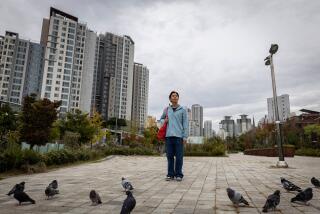Wave of South Korean Visitors to U.S. Is Gaining Momentum : Tourism: So far this year, their numbers are up 44%. The Southland--and especially its theme parks--is a big draw.
- Share via
The flood of Japanese visiting the United States gets plenty of attention, but tourists from South Korea are now getting some too.
Although the number of Korean tourists is small by comparison with the Japanese, they represent an emerging market for the United States, and particularly Los Angeles, which has the largest Korean community outside the country itself. The number of South Korean visitors nationally in the first four months of this year--a traditionally slow period for tourism--increased 44% to 57,260. For 1990, the United States Travel and Tourism Administration has forecast a 23% increase to 184,000.
The U.S. State Department bureau of consular affairs projects that 205,000 non-immigrant visas will be issued to South Koreans during the 12 months ending Sept. 30. For the same period a year ago, 160,500 non-immigrant visas were issued.
After South Korea lifted restrictions on overseas travel early last year, the number of Koreans visiting the United States shot up 62% to 149,323 in 1989. Previously, to conserve foreign exchange, the South Korean government restricted each South Korean to no more than two holidays abroad a year. To get a passport, a South Korean had to get an invitation from a resident of a foreign country. The U.S. government had encouraged South Korea to make foreign travel easier to help reduce the American trade deficit with Korea.
Anticipating that the number of tourists will keep growing, the California Office of Tourism is busy translating its information brochure on California--available in five languages--into Korean as well.
“Travel agents and the media (in Korea) were hungry for information on California,” said Florence Snyder, director of California’s tourist office, who led a trade mission in mid-July to South Korea.
Although South Koreans are the fastest-growing segment of tourists from overseas, there are far more Japanese visitors to the United States. The number of Japanese tourists grew 22% last year to more than 3 million, and the forecast for this year is 12% growth to 3.46 million.
Many South Korean visitors come to the Los Angeles area, with its estimated 300,000 Korean residents. “Many people have families in Korea and Los Angeles, and they visit each other. The visitors also look for business in the United States, so they visit Los Angeles,” said Sung P. Chung, vice president of Hodory Tourist Corp. The travel agency in Koreatown handled 3,000 Korean clients last year and expects 5,000 this year.
Cho Chun Sook, a 36-year-old housewife, spent a week out of her 16 days in the United States visiting her sister-in-law in Tujunga. Businessman J. H. Chun, who runs a garment trading company, came to Los Angeles to sightsee and to examine merchandise.
To take advantage of the increased travel between South Korea and the United States, Dynamic Tour-USA will open an additional office in Seoul this October. “We’ve seen a definite increase every year,” said James Shim, president of the Los Angeles-based agency. The firm handled 1,800 South Korean travelers last year, and Shim expects to do business with 2,600 in 1990.
With a boom in travel between South Korea and the United States, United Airlines, a newcomer to the Los Angeles-Seoul route, is increasing its nonstop service. Introduced in May this year, its thrice-weekly service became a daily service after Aug. 18.
“We hope to increase passenger traffic from Korea to the United States this year by 66% over last year,” said a United spokeswoman. “To meet increased demand on a weekly basis, we have increased the number of available seats by 166% for our service to and from Seoul this year.”
Meanwhile, Korean Air plans to increase its daily nonstop service by four flights a week after October.
Most Koreans who come here on tours choose a 15-day package that costs $3,700 per person, including air fare, hotel and food. Those who come to the West Coast like to visit Universal Studios, Disneyland, the Grand Canyon, Yosemite Park and San Francisco.
Universal Studios has seen a “sharp 133% increase over the same period last year in Korean visitors as of July 1, but this is not based on extremely large numbers,” said Universal Studios spokeswoman Joan Bullard. Declining to disclose actual figures, she said Koreans ranked 12th in the number of visitors during the first half of this year, with Japanese in the No. 2 slot after Canadians.
At a time business from other American states and Europe is soft, the increase from South Korea and elsewhere in Asia “doesn’t make up for it but certainly is a recognizable increase,” Bullard noted.
South Koreans aren’t as big spenders as the Japanese--in cash, at least. The Korean government restricts each traveler to $5,000 in cash per trip. However, some spend freely with credit cards.
At least 300 Korean shoppers have gone into Fred Jewelers in Beverly Hills this year, a 45% increase over the same period last year. “They spend a lot of money, on average $5,000 per person,” said Julie Lee, who was hired by the French jewelry store because she speaks Korean. “They like to buy Rolex watches and also solitaire diamonds.”
The jewelry store has been advertising in Korean magazines and newspapers here. Added Lee: “Starting from April this year, the Koreans are beginning to buy our merchandise. From now on, I’m sure it’s really going to be big business.”
More to Read
Sign up for The Wild
We’ll help you find the best places to hike, bike and run, as well as the perfect silent spots for meditation and yoga.
You may occasionally receive promotional content from the Los Angeles Times.






